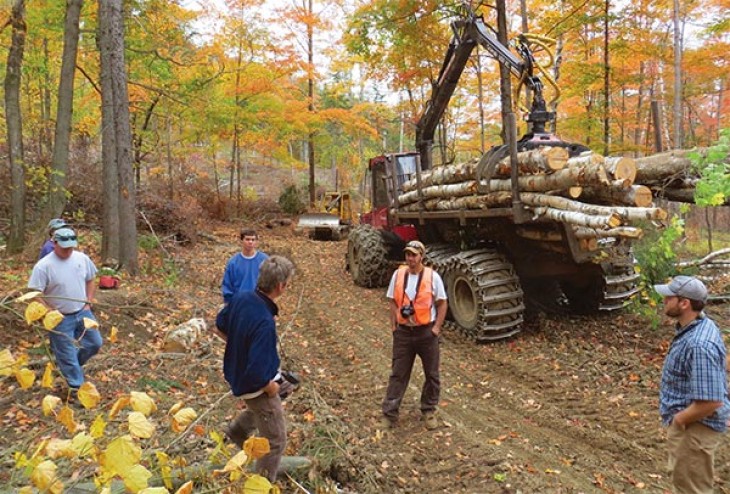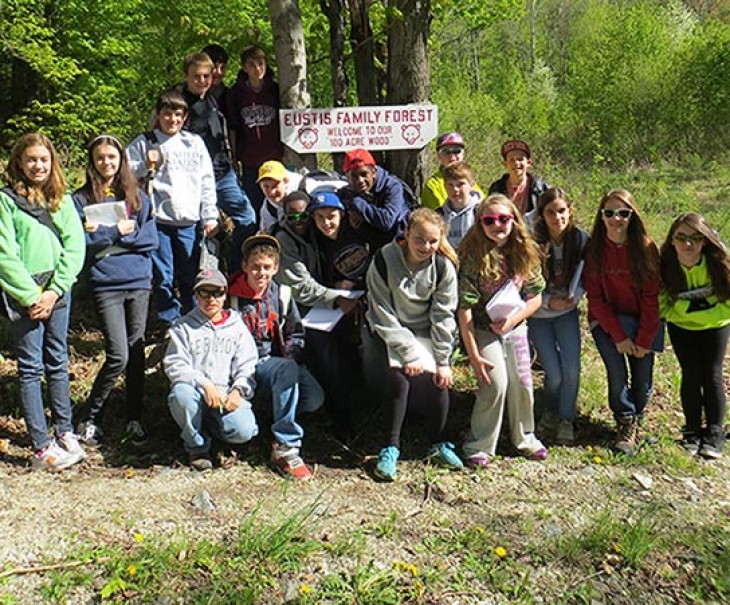We’ve owned our forest in Starksboro, Vermont, since 2005, and have added to it over the years by purchasing adjacent properties; the entire parcel now totals 290 contiguous acres. We spent the first few years of ownership investing in the property: researching boundary lines and property history, surveying, reclaiming old trails, creating connector trails, and managing water on all trails. Time was also spent inventorying, mapping natural communities, and planning. The property is quite diverse, with ridgetop, mid-slopes, and also some wetlands. The historical uses of the land are also varied. Some of it was cleared and used for agri-culture and sugaring only in the 1800s. Another area was used only as a timber lot and never settled, and one section was a working farm until 1941.
I am an electrical engineer (at GlobalFoundries) but also have a forest science minor from Penn State University. Our forest management goals are recreation, education (for ourselves and others), and investment (future timber value). We attempt to be good stewards of our forest, keeping in mind wildlife, cultural history resources, water, and soils. I am the primary forester for the property but have worked with many others in the management of the land, including county forester Chris Olson, consulting foresters Harris Roen and John Fogarty, forester and logger Grahm Leitner, plants and wetlands expert Barb Otsuka, forestry and wildlife consultant Susan Morse, and several talented excavation contractors who have helped with the construction improvements of forest trails and roads.
My goal in all harvests is to leave the residual stand with a higher percentage of high quality trees than before the harvest. In 2013, we completed four types of harvests: a roughly five-acre patch cut with 90 percent of overstory cut; an adjacent seven-acre shelterwood with 50 percent of the overstory cut; 15 acres of “traditional” small group/single tree harvesting with, on average, 35 percent of the overstory cut; and another three acres of crop tree release with 25 percent of the overstory cut. Near the shelterwood was also a previous seven-acre timber stand improvement thinning, completed in 2011.
By having these different harvests in close proximity, we created what foresters call horizontal diversity – that is, a bunch of different forest types right next to each other. This is beneficial to wildlife and makes for a more resilient forest. The decision on how to treat each area was made by the quality of the trees and their density. For example, in the patch cut area the trees were poorly formed and very crowded; there was little understory. And so by cutting heavily, we created some nice early-successional habitat for wildlife, and from a crop tree perspective, started over. In areas where there were desirable trees, we cut less, but still created openings to stimulate understory growth and some regeneration. By releasing the crop trees we gave them more room to grow, and from a wildlife perspective our thinning helped create an irregular forest canopy (vertical diversity) which is beneficial to wildlife in a different way than horizontal diversity.
In all harvests, we try to promote mast species such as oak, serviceberry, and black cherry. The locally rare oak, in particular, gives wildlife a second source of hard mast, helping especially in years when beech nut availability is below normal. In a 2014 one-acre patch cut, I spread 13,000 acorns, hoping that by spreading so many the animals wouldn’t be able to consume them all.
In 2011, we did some focused wildlife improvements – we created two permanent, half-acre, early-successional areas surrounding a large grass field and willow/alder wetlands and restored an adjacent quarter-acre pond. A variety of soft mast shrubs like American highbush cranberry were planted around the pond. This area is now a wildlife “hot spot” with food, cover, and water.
The two primary markets of my sawlogs have been Rutland Plywood (prior to the fire at their plant) and Manchester Lumber (in Johnson, Vermont). In addition to firewood and pulp, a fourth forest product, birch bark, was peeled off to-be-cut paper birch by Long View Forest Management prior to each harvest.
Part of the enjoyment I get from the land comes from helping to educate others: 2015 marked the tenth year I’ve brought the seventh grade class from St. Francis Xavier School in Winooski to our property for an all-day field trip and lessons about stewardship, forestry, wildlife, and landscape changes over time. It is one of my favorite days each year. It is amazing to see the kids’ eyes opened to the forest around them. So many people walk through the woods but never “see” all that is around them. Once you know where to look, you realize how many things are out there to observe. We hope to spark a lifelong interest in forests so the kids go on to hunt, hike, and otherwise enjoy Vermont’s forests. With luck, they will appreciate them more, will advocate for them, and hopefully some will pursue one of the many careers available working with forests. Some may eventually become stewards of their own working forests.
This series is sponsored by the Stifler Family Foundation, in support of forestry practices that promote healthy and sustainable forests and wildlife habitat.





Discussion *